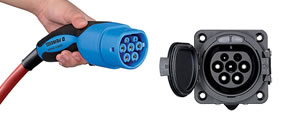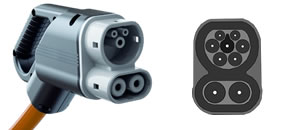
AC Charging
Charge port
Type 2
Max. AC power output
11 kW
Charging time
8h 15m

DC Charging
Charge port
CCS
Max. AC power output
135 kW
Charging time
28m
Find key electric car specifications including range, charging time, price, and the ideal charging station.
The Volkswagen ID.4 is an electric urban SUV characterized by its spacious, modern, and minimalistic interior. On the exterior, clean aerodynamic lines make for a striking presence on the road.
82 kWh
550 km
€ 49.990
159 Wh/km
5
Yes

Charge port
Type 2
Max. AC power output
11 kW
Charging time
8h 15m

Charge port
CCS
Max. AC power output
135 kW
Charging time
28m
Charging type
Wall plug (2.3 kW)
Time (empty to full)
39h 30m
Range per hour of charging
14 km/h
Our recommendation
This charging method is for emergencies only.
Charging type
1-phase 16A (3.7 kW)
Time (empty to full)
24h 30m
Range per hour of charging
22 km/h
Our recommendation
This charging station takes longer to fully charge this car.
Charging type
1-phase 32A (7.4 kW)
Time (empty to full)
12h 15m
Range per hour of charging
45 km/h
Our recommendation
This charging station takes longer to fully charge this car.
Charging type
3-phase 16A (11 kW)
Time (empty to full)
8h 15m
Range per hour of charging
67 km/h
Our recommendation
This charging station is the best fit for this car!
This charging station will enable you to charge this car at the maximum possible charging speed.
Charging type
3-phase 32A (22 kW)
Time (empty to full)
8h 15m
Range per hour of charging
67 km/h
Our recommendation
This charging capacity is higher than your car can handle.
Read our comprehensive guide to discover everything you need to know about electric vehicle charging before buying an electric car.
The time it takes to charge the Volkswagen ID.4 varies based on the battery size of the version of the ID.4 you purchase, and the type of charging station you charge at. As for battery size, the VW ID.4 Pure and Pure Performance* both have a 52 kWh usable battery capacity, and the VW ID.4 Pro, Pro Performance*, and GTX versions all have a 77 kWh usable battery capacity.
At an AC charging station, the ID.4 Pure and Pure Performance can both charge at a maximum power of 7.2 kW. This means to charge from 0 to 100 percent takes around 8 hours and 30 minutes. As for the ID.4 Pro, Pro Performance, and GTX, charging from 0 to 100 percent takes around 8 hours and 15 minutes of charging at a maximum power of 11 kW.
DC fast charging on the other hand can charge the ID.4 Pure and Performance from 10 to 80 percent in 33 minutes at a maximum power of 118 kW and the ID.4 Pro, Pro Performance, and GTX from 10 to 80 percent in 33 minutes at a maximum power of 135 kW.
*Depending on your location, model names may differ.
The Volkswagen ID.4 is currently available in five models* each with a different range:
*These estimates are based on the WLTP ratings and the actual range may vary based on factors such as speed, weather conditions, and elevation change.
**Depending on your location, model names may differ.
Depending on which version of the Volkswagen ID.4 you choose and your location or dealership, the starting price ranges between £34,995 and £49,025* in the UK.
*Prices were taken from Volkswagen at the time of writing.
Categorised as a medium five-seater SUV, the Volkswagen ID.4 is 4,584 mm long, 1,852 mm wide, and 1,640 mm tall. The Volkswagen ID.4 has a 543-litre cargo load, with a maximum cargo load of 1,575 litres. The gross vehicle weight (GVWR) of the Volkswagen ID.4 is between 2,480 and 2,750 kg, with a maximum payload of between 589 and 611 kg depending on the version.
The amount it costs to charge your Volkswagen ID.4 depends on which model you are charging and what type of charging station you use, be this using a home charger, public charger, or a DC fast charger. The table below gives you an approximation of what you could expect to pay.
| Charging station type (right) Audi e-tron version (below) | Home (AC) cost per kWh: £0.28 | Public (AC) cost per kWh: £0.34 | Fast (DC) cost per kWh: £0.54 |
| Pure & Pure Performance* (52 kWh) | £14.56 | £17.68 | £19.66 |
| Pro, Pro Performance & GTX* (77 kWh) | £21.56 | £26.18 | £29.11 |
Important: Prices are approximations based on our experience and do not represent the real-life situation and represent the cost to charge from zero to 100 percent SoC for AC and from 10 to 80 percent for DC.
*Depending on your location, model names may differ.